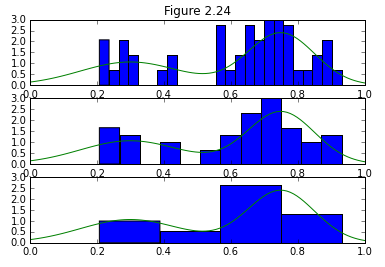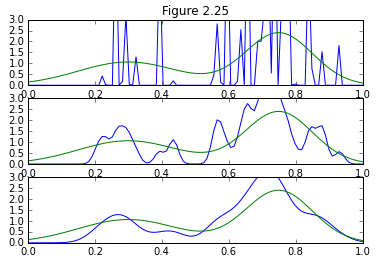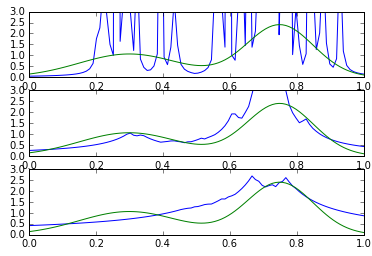パターン認識と機械学習、第2章からは「2.5.2 ノンパラメトリック手法」を実装します。
取り出してきたデータの数を数え上げて、確率分布を把握する手法が紹介されてます。
この章はあんまり時間かけてもしょうが無いなと感じたので、さくっと実装。
カーネル密度法もスクラッチせず、scipyのパッケージ使ってズルしました。
ヒストグラム・コード
import numpy as np
import matplotlib.pyplot as plt
from pylab import *
from scipy import stats
from scipy.stats.kde import gaussian_kde
import random
def mix_G(x):
return (0.4 * G1 + 0.6 * G2)
def mix_G_distribution(n):
ratio = 0.3
if random.random() <ratio:
return random.gauss(M1, S1)
else:
return random.gauss(M2, S2)
if __name__ == "__main__":
x = np.linspace(0, 1, 100)
# Set normal distribution1
M1 = 0.3
S1 = 0.15
G1 = stats.norm.pdf(x, M1, S1)
# Set normal distribution1
M2 = 0.75
S2 = 0.1
G2 = stats.norm.pdf(x, M2, S2)
N = 50
Data = [mix_G_distribution(n) for n in range(N)]
plt.subplot(3, 1, 1)
plt.hist(Data, bins=1/0.04, normed=True)
plt.plot(x, mix_G(x), "g-")
plt.xlim(0, 1)
plt.ylim(0, 3)
title("Figure 2.24")
plt.subplot(3, 1, 2)
plt.hist(Data, bins=1/0.08, normed=True)
plt.plot(x, mix_G(x), "g-")
plt.xlim(0, 1)
plt.ylim(0, 3)
plt.subplot(3, 1, 3)
plt.hist(Data, bins=1/0.25, normed=True)
plt.plot(x, mix_G(x), "g-")
plt.xlim(0, 1)
plt.ylim(0, 3)
結果
カーネル密度法・コード
if __name__ == "__main__":
#Karnel density estimation
from scipy.stats.kde import gaussian_kde
plt.subplot(3, 1, 1)
plt.plot(x, gaussian_kde(Data, 0.005)(x))
plt.plot(x, mix_G(x), "g-")
plt.xlim(0, 1)
plt.ylim(0, 3)
title("Figure 2.25")
plt.subplot(3, 1, 2)
plt.plot(x, gaussian_kde(Data, 0.07)(x))
plt.plot(x, mix_G(x), "g-")
plt.xlim(0, 1)
plt.ylim(0, 3)
plt.subplot(3, 1, 3)
plt.plot(x, gaussian_kde(Data, 0.2)(x))
plt.plot(x, mix_G(x), "g-")
plt.xlim(0, 1)
plt.ylim(0, 3)
結果
K近傍法・コード
#k_Neighbourhood
def k_NN(test, train, k):
train = np.array(train)
train.sort()
r = []
for i in test:
distance = abs(train - i)
distance.sort()
r.append(distance[(k-1)])
r = np.array(r)
return k / (2* r * N)
if __name__ == "__main__":
title("Figure 2.26")
plt.subplot(3, 1, 1)
plt.plot(x, k_NN(x, Data, 1))
plt.plot(x, mix_G(x), "g-")
plt.xlim(0, 1)
plt.ylim(0, 3)
plt.subplot(3, 1, 2)
plt.plot(x, k_NN(x, Data, 10))
plt.plot(x, mix_G(x), "g-")
plt.xlim(0, 1)
plt.ylim(0, 3)
plt.subplot(3, 1, 3)
plt.plot(x, k_NN(x, Data, 30))
plt.plot(x, mix_G(x), "g-")
plt.xlim(0, 1)
plt.ylim(0, 3)


